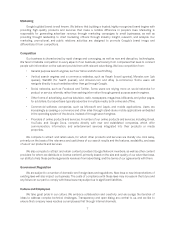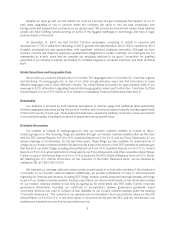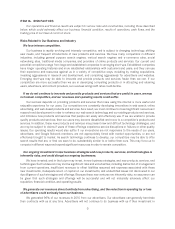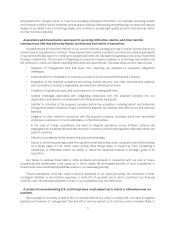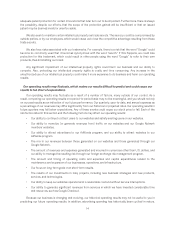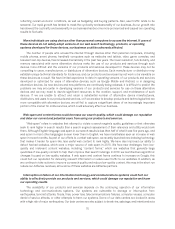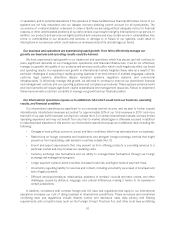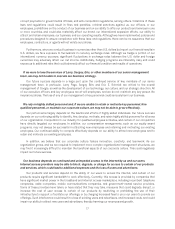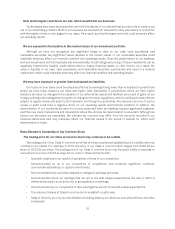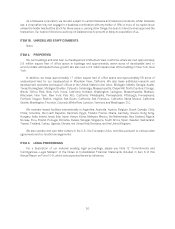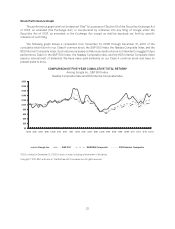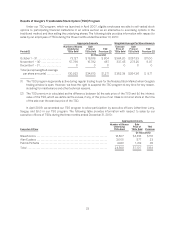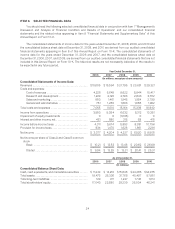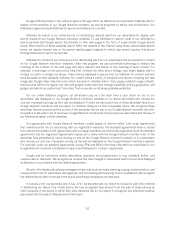Google 2010 Annual Report Download - page 29
Download and view the complete annual report
Please find page 29 of the 2010 Google annual report below. You can navigate through the pages in the report by either clicking on the pages listed below, or by using the keyword search tool below to find specific information within the annual report.of vandalism, and to potential disruptions if the operators of these facilities have financial difficulties. Some of our
systems are not fully redundant, and our disaster recovery planning cannot account for all eventualities. The
occurrence of a natural disaster, a decision to close a facility we are using without adequate notice for financial
reasons, or other unanticipated problems at our data centers could result in lengthy interruptions in our service. In
addition, our products and services are highly technical and complex and may contain errors or vulnerabilities. Any
errors or vulnerabilities in our products and services, or damage to or failure of our systems, could result in
interruptions in our services, which could reduce our revenues and profits, and damage our brand.
Our business and operations are experiencing rapid growth. If we fail to effectively manage our
growth, our business and operating results could be harmed.
We have experienced rapid growth in our headcount and operations, which has placed, and will continue to
place, significant demands on our management, operational, and financial infrastructure. If we do not effectively
manage our growth, the quality of our products and services could suffer, which could negatively affect our brand
and operating results. Our expansion and growth in international markets heighten these risks as a result of the
particular challenges of supporting a rapidly growing business in an environment of multiple languages, cultures,
customs, legal systems, alternative dispute resolution systems, regulatory systems, and commercial
infrastructures. To effectively manage this growth, we will need to continue to improve our operational, financial
and management controls, and our reporting systems and compliance procedures. These systems enhancements
and improvements will require significant capital expenditures and management resources. Failure to implement
these improvements could hurt our ability to manage our growth and our financial position.
Our international operations expose us to additional risks which could harm our business, operating
results, and financial condition.
Our international operations are significant to our revenues and net income, and we plan to further expand
internationally. International revenues accounted for approximately 52% of our total revenues in 2010, and more
than half of our user traffic has been coming from outside the U.S. In certain international markets, we have limited
operating experience and may not benefit from any first-to-market advantages or otherwise succeed. In addition
to risks described elsewhere in this section, our international operations expose us to additional risks, including the
following:
• Changes in local political, economic, social, and labor conditions, which may adversely harm our business.
• Restrictions on foreign ownership and investments, and stringent foreign exchange controls that might
prevent us from repatriating cash earned in countries outside the U.S.
• Import and export requirements that may prevent us from offering products or providing services to a
particular market and may increase our operating costs.
• Currency exchange rate fluctuations and our ability to manage these fluctuations through our foreign
exchange risk management program.
• Longer payment cycles in some countries, increased credit risk, and higher levels of payment fraud.
• Uncertainty regarding liability for services and content, including uncertainty as a result of local laws and
lack of legal precedent.
• Different employee/employer relationships, existence of workers’ councils and labor unions, and other
challenges caused by distance, language, and cultural differences, making it harder to do business in
certain jurisdictions.
In addition, compliance with complex foreign and U.S. laws and regulations that apply to our international
operations increases our cost of doing business in international jurisdictions. These numerous and sometimes
conflicting laws and regulations include internal control and disclosure rules, data privacy and filtering
requirements, anti-corruption laws, such as the Foreign Corrupt Practices Act, and other local laws prohibiting
16



